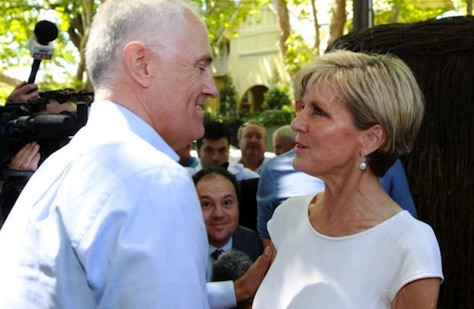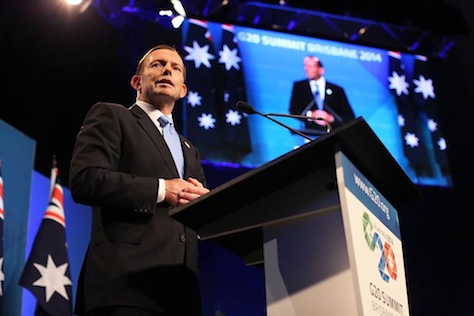More than an unpopular mining tax or one of the world’s most progressive carbon trading schemes, Australian voters booted the last Labor government as a punishment for the personality-driven drama between Kevin Rudd and Julia Gillard who, in six years of government, traded the premiership twice and fought through four different leadership battles.![]()
Rudd eventually returned to leadership in the summer of 2013 when its fickle members worried that sticking with Gillard would result in an electoral catastrophe. Labor lost the election anyways, and Tony Abbott, the conservative leader of the opposition Liberal/National Coalition, became prime minister.
Just 17 months after taking office, however, Abbott now faces the same dynamic, and Australia’s prime minister survived a ‘leadership spill’ earlier this week by a narrow margin of 66 to 39. If successful, the challenge would have opened the way for a direct leadership contest, presumably against either two more popular figures — communications leader (and former Liberal leader) Malcolm Turnbull or Australia’s foreign minister Julie Bishop, a rising star.
The leadership wobbles point to a growing trend of snap leadership contests that are reshaping Australian politics by narrowing the time horizons for leaders of both major parties. Though that makes party leaders conceivably much more responsive to their colleagues and it also gives individual government ministers more power and leverage, it correspondingly creates uncertainty and drives weaker leadership. Think, for example, of the rotating-door premierships so common in Japan or Italy for much of the post-war era.
Why Abbott was so vulnerable
Abbott largely did what he said he would do when he was elected in September 2013. He’s deployed enough military personnel and detained enough asylum seekers at detention centers in Papua New Guinea to sufficiently disincentivize immigrants from attempting the dangerous trek to Australia by boat. He successfully won enough support among the Australian Senate’s independents to kill both Rudd-Gillard era accomplishments — first, their landmark carbon trading scheme and, a month later, an unpopular tax on mining profits (that, in any event, raised far less revenue than initially anticipated). For good measure, Abbott finalized two key free trade deals, with Japan and with South Korea, at a time when the Australian economy is reeling from both China’s economic slump and a decline in global commodities prices. In the crisis over downed Malaysian Airline flight 370, he showed genuine regional leadership, especially in contrast to the Malaysian government. In Abbott, Australians got exactly the prime minister that was advertised — a passionate right-wing conservative not afraid of controversy.
But that meant that Abbott too often embraced awkward positions.That includes an emphasis on social policy, including opposition to same-sex marriage, far to the right of most Australian voters. It also includes his odd enthusiasm for restoring knighthood honors in Australia, a practice that was abolished in the 1980s, an electorate that now leans away from monarchy and toward republicanism. Most recently, he had the temerity to bestow one of Australia’s revived knighthoods on Prince Philip, the husband of Queen Elizabeth II, a move that went down horribly even among his allies by reinforcing Abbott’s monarchism. When he and treasurer Joe Hockey introduced budget cuts last year, they set into motion the Coalition’s slide in the polls, especially among middle-class voters angry over the Coalition government’s attempts to introduce a co-payment for general practitioner visits. For more than a year, Abbott’s unpopularity has given Labor, with a fresh leader in Bill Shorten, an edge looking toward the next national election, a trend confirmed by state election victories in Victoria last November and Queensland on January 31. The latest Feb. 6-8 Newspoll shows Abbott’s Coalition winning just 43% of the ‘two-party preferred’ vote to Labor’s 57%.
What past leadership challenges tell us about Abbott’s future
Leadership spills are part of a growing tradition in Australian politics, increasingly so among the Coalition, so much so that they’ve become a regular, unexceptional part of political life.
The most ominous example for Abbott is 1991, when treasurer Paul Keating challenged longtime prime minister Bob Hawke for the Labor Party leadership in June of that year. Keating fell short by a margin of 66 to 44, but it was enough to weaken Hawke so that by December, in a second leadership contest, Keating defeated Hawke by a margin of 56 to 51, bringing an end to Hawke’s eight-year premiership (the longest of any Labor prime minister). Keating would go on to win the 1993 federal election, and he ultimately served five years as prime minister himself.
With nearly 40% of Coalition backbenchers already willing to dump Abbott, it’s hard to believe that, in another five months, they will suddenly have a change of hear, especially if the party’s polling fortunes haven’t reversed. If a more popular (and moderate) figure like Turnbull or Bishop steps forward to challenge Abbott directly, the temptation to dump Abbott will be strong.
Labor, though the years, became much more comfortable with the traditional of regicidal leadership challenges than the Liberals. In 2003, Kim Beazley’s unsuccessful leadership challenge to then-leader Simon Crean exacerbated Crean’s troubles, which led to Crean’s resignation later that year, when Beazley assumed the leadership. In December 2006, Rudd, then a shadow foreign minister, toppled Kim Beazley as Labor leader in the lead-up to the 2007 federal elections.
Rudd, famously, fell to a leadership spill of his own in June 2010 when Labor figures deemed him too difficult and too unpopular to continue, preferring his deputy instead, who became Australia’s first female prime minister. Rudd attempted a comeback in February 2012 with a direct challenge to Gillard, which cost him his position as foreign minister. His supporters attempted another comeback in March 2013 when it became clear that Gillard would likely lose the next federal election. Only on his third attempt, in June 2013, did Rudd reclaim the premiership.
But the Liberals are now embracing the practice with enthusiasm as well. When John Howard lost the 2007 election, Turnbull narrowly lost the ensuing leadership race to Brendan Nelson. Within nine months, Turnbull had gained enough support to defeat Nelson in a sudden leadership spill in September 2008.
Turnbull himself suffered the same fate in December 2009, when Abbott (and Hockey) challenged Turnbull. Though Turnbull was always a popular opposition leader, Abbott fully opposed the Rudd government’s carbon emissions trading scheme, while Turnbull supported it. Abbott ultimately defeated Turnbull in the second round by a margin of 42 to 41, led the Coalition through the 2010 and 2013 elections and ultimately led the legislative fight to repeal the scheme last year.
So none of the players in the current situation are averse to triggering a fresh leadership spill in two months. Or three. Or four. Or five.
Abbott is now attempting to correct course, in part, by inexplicably shelving his signature (and popular) plan to extend paid parent leave, which was at the heart of his 2013 election campaign.
 Photo credit to Edwina Pickles / Sydney Morning Herald.
Photo credit to Edwina Pickles / Sydney Morning Herald.
In the meanwhile, however, expect the Australian media and other Liberal (and some Labor) figures to keep the pressure on Abbott, who has been a fixture in top-level politics long enough to know that the odds are against him. Also watch for the maneuvering between Turnbull and Bishop (pictured above), who will almost certainly be engaged in a behind-the-scenes contest to emerge as the likeliest successor to Abbott in any future leadership spill. If one of them emerges as the next leader, it is likely that he or she will lead the Liberals into the next election, which must be held before January 2017.
If a strong post-Abbott Liberal leader emerges with united support among the party and the Coalition, that will be long enough to repair the damage from an internal tussle, but Shorten must now be relieved that it’s the Liberal Party, and not Labor, that’s tearing itself apart over personnel.
Though if, say, Turnbull steals the leadership from Abbott, how long will it take for Bishop to mount her own leadership spill against him? If Shorten takes power, how long will it take his own Labor rivals, including the more populist Anthony Albanese to paint Shorten as too pusillanimous? Ultimately, Australians must wonder if the path of regular leadership spills are destabilizing the nature of politics and policymaking.
